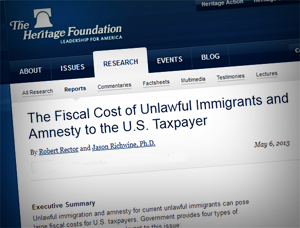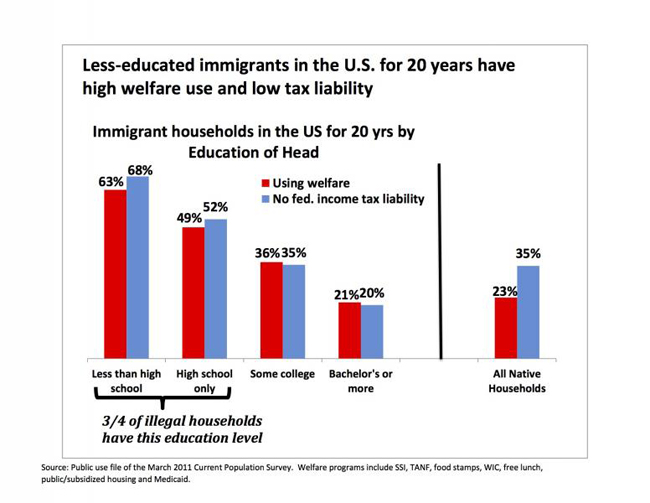National Review Online, May 14, 2013

I have worked on the issue of immigration’s fiscal impact for a long time, having presented my first academic paper on the subject at the annual meeting of the American Sociological Association almost two decades ago. I can thus say with confidence that the Heritage Foundation’s recent report on the fiscal cost of illegal immigrants is the most detailed and exhaustive ever done on this topic.
The report’s lead author is Robert Rector, intellectual godfather of welfare reform. Rector finds that illegal-immigrant households use about $55 billion more in services than they pay in taxes each year. Under the Schumer-Rubio bill, they would begin to get permanent legal status (green cards) in about ten years and would access more programs; then, the annual costs would balloon to $106 billion a year. The total fiscal costs over the lifetime of illegal immigrants, if they receive amnesty, would be $6.5 trillion. Some, even on the right, have criticized his analysis, but the basic findings are unassailable for reasons I will explain.
In the modern American economy, those with relatively little education (immigrant or native) earn modest wages on average and make modest tax contributions. Their low average incomes mean that they or their children can often access welfare and other means-tested programs. As a group, the less educated use more in services than they pay in taxes. Anyone who argues otherwise is either lying or grossly uninformed.
Education matters so much to the illegal-immigration debate because all researchers agree that about half of adult illegal immigrants have less than a high-school education, and another quarter have only a high-school education. The Heritage study identifies this as the key reason that letting illegal immigrants stay creates huge fiscal costs. As illegal immigrants are on average only 34 years old, the cost over the next five decades will be enormous.
As the Heritage study points out, the average household in America receives more than $31,000 in government benefits and services — federal, state, and local, minus pure public goods such as defense and interest on the debt. Very roughly, this is the median income of a household headed by an immigrant with a high-school education or less. There is no way for these households to pay enough in taxes to cover even the average consumption of public services.
What’s more, these households are relatively large and on average receive a good deal more in public services than $31,000. Until government is cut by at least half, the less educated will be a significant fiscal drain. This does not make the less educated bad people. It simply reflects the realities of the modern American economy and the existence of a huge administrative state.
The accompanying figure shows welfare use and income-tax liability for households headed by an immigrant who has lived here for 20 years, and who thus is not a new arrival.

The figure shows that 63 percent of households headed by immigrants who have not completed high school and have lived here for 20 years access one or more welfare programs, and 68 percent have zero federal income liability. Of households headed by an immigrant with only a high-school education (and who has lived here for 20 years), 49 percent use welfare and about half have no federal income-tax liability. While not a fully developed model like the Heritage study, the figure demonstrates why less educated immigrants are on average a net fiscal drain, even after they have been here for two decades.
It is worth pointing out that 86 percent of immigrant households accessing the welfare system have at least one worker. But working does not eliminate one’s ability to collect welfare, particularly non-cash welfare and other means-tested programs, if one’s income is low enough.
The graph includes both legal and illegal immigrants, which actually reduces the welfare use rates somewhat. That is, less educated legal immigrants have even higher welfare use than less educated illegal immigrants. This is why Heritage’s study finds that giving illegal immigrants legal status raises costs dramatically.
Proponents of amnesty, led by the Cato Institute, have offered some rather silly arguments to attack Heritage. First, some critics contend that less educated immigrants are no worse for the nation’s fisc than less educated native-born Americans. This is mostly true. But it in no way justifies allowing into the country additional less educated immigrants, who will compound the problem.
Some also argue that Rector’s methodology is non-standard because it looks at taxes paid and services used by households rather than individuals. In fact, this is the standard way to look at the issue. The National Research Council (NRC) used households in some of the fiscal analyses it did of immigrants, as did the Urban Institute in its tax studies in 1995 and 2006. Princeton economist Thomas Espenshade also used households in his fiscal analysis of New Jersey’s immigrants.
The late Julian Simon, who was at Cato and shaped the institute’s views of immigration, used this approach as well, with data from the 1970s. But now that the numbers do not come out positive, Cato does not like Simon’s method. The way Heritage looked at the fiscal impact of immigrants is the main way most researchers have done this kind of work.
The primary concern about looking at households is that this approach includes U.S.-born children, who critics argue should not be counted. But Simon himself pointed out that the fiscal impact must include both the immigrant and the family “he brings or acquires.” After all, the children are here only because their parents have been allowed into the country. It is also worth noting that the NRC study in 1997 did an analysis that excluded U.S.-born children, and it still found that less educated immigrants were a large fiscal drain.
Others argue that because the Schumer-Rubio bill limits welfare access for the first ten years after legalization, there is nothing to worry about. But the Heritage study shows that illegal-immigrant households already receive about $4,500 a year on average from means-tested programs. The U.S.-born children of illegal immigrants have access to all programs, the ban does not apply to every program, and the administration of these programs is far from airtight. Finally, as the Heritage study makes clear, when the ten-year window expires, the costs explode.
Another criticism of the Heritage study is that it does not take into account that the legalized illegal immigrants will do better over time. This is simply false; the Heritage study does assume that incomes will rise both with legalization and over time. But this does not mean that illegal immigrants will come even close to providing a net fiscal benefit to the nation. As the accompanying graph makes clear, even less educated immigrants who have lived in the United States for 20 years have very high welfare use and very low tax liability. Heritage’s findings simply reflect this fact.
Probably the main argument of critics is that the economic benefits we gain from having access to immigrant labor will offset the fiscal costs. There is simply no evidence for this. The National Research Council study mentioned above, which was authored by many of the leading economists in the field, is the only study of which I am aware that tried to measure both the economic impact and the fiscal impact of all immigrants. That study found that the economic gain to the native-born from all immigrants was smaller than the fiscal drain created by all immigrant households. And that finding was for all immigrants, not only illegal immigrants, who have on average just ten years of schooling.
In a recent paper for my organization, the nation’s top immigration economist, Harvard’s George Borjas, summarizes the economic literature and observes, “Immigration is primarily a redistributive policy.” As Borjas explains, the immigrants themselves may benefit a great deal by coming to America, but the gain to natives from illegal immigration is estimated at 0.06 percent of GDP: six one-hundredths of 1 percent.
To assume that immigration creates large gains to natives, one must invent benefits that are not demonstrated in the academic literature. The worst example of ignoring the immigration literature is a widely cited op-ed piece by former McCain adviser Douglas Holtz-Eakin. I published a long critique of his article here.
The central point of Holtz-Eakin’s “dynamic analysis” is the contention that immigration-induced population growth, by itself, will have a positive impact on the economy and public coffers. But to reach his conclusion, Holtz-Eakin ignores the economic literature showing that immigration only slightly increases the income of natives. He also ignores the literature on development indicating that population growth does not increase per capita GDP growth. Worst of all, he ignores the research that has examined the actual impact of immigration on public coffers, which shows that education at arrival is the key determinant of immigrants’ fiscal impact.
To offset the enormous fiscal costs that the less educated create, illegal immigration would have to dramatically increase the income of natives. There is simply no objective research showing this is the case. Of course, immigration does make the economy larger. But, as Borjas points out, of the increase in the size of economy that immigration creates, “97.8 percent goes to the immigrants themselves in the form of wages and benefits.”
It is true that immigrants came to America 100 years ago and did not create a large fiscal drain. But government was a tiny fraction of what it is today, so the arrival of low-income immigrants could not create a large fiscal drain. Heritage’s study, as well as common sense, makes clear that advocates of smaller government have to oppose amnesty and support very selective immigration policies until the day that government spending is cut dramatically. Otherwise the fiscal cost will be enormous.
